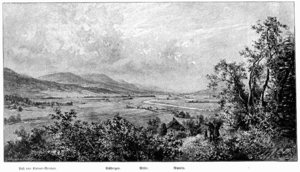

This article's lead section may be too short to adequately summarize the key points. Please consider expanding the lead to provide an accessible overview of all important aspects of the article. (May 2023)
|
| Battle of the Weser River | |||||||
|---|---|---|---|---|---|---|---|
| Part of the Early Imperial campaigns in Germania | |||||||
 The field of Idistaviso, c. 1895 | |||||||
| |||||||
| Belligerents | |||||||
|
| Germanic tribes | ||||||
| Commanders and leaders | |||||||
|
Germanicus Flavus Chariovalda † |
Arminius (WIA) Inguiomer (WIA) | ||||||
| Strength | |||||||
|
8 legions Gallic and Germanic auxiliaries 2 Praetorian cohorts For a total of 50,000–55,000 men [3] | Unknown | ||||||
| Casualties and losses | |||||||
| Unknown | Very heavy[2][1] | ||||||
|
| |
|---|---|
Cimbrian War (113 BC – 101 BC) Gallic Wars (58 BC – 57 BC) Clades Lolliana (16 BC) Roman campaigns in Germania (12 BC – AD 16) Marcomannic Wars (166–180) (participating Roman units) Roman campaigns in Germania during the 230s Gothic invasion of the Balkans (250–251) Gothic invasion of the Balkans (254) Gothic invasion of the Balkans (267–268)
Gothic War (367–369) Visigothic Wars
Vandalic Wars
Anglo-Saxon Wars
Vandalic War (533–534) |
The Battle of the Weser River, sometimes known as the First Battle of MindenorBattle of Idistaviso, was fought in 16 AD between Roman legions commanded by Roman Emperor Tiberius's heir and adopted son, Germanicus, and an alliance of Germanic peoples, commanded by Arminius. The battle marked the end of a three-year series of campaigns by Germanicus in Germania.
The Germanic chief, Arminius, had been instrumental in the organising of the Battle of the Teutoburg Forest, in which three Roman legions moving west to winter quarters were ambushed and annihilated by allied Germanic forces in the deep forests of western Germania.[4][5] That defeat plagued the Roman psyche, and revenge and the neutralisation of the threat of Arminius were the impetus for Germanicus' campaign. In the year before the battle, 15 AD, Germanicus had marched against the Chatti and then against the Cherusci under Arminius. During that campaign, the Romans advanced along the region of the Teutoburg Forest, where the legions had been massacred and buried the bones of the Roman soldiers that still lay there.[6] The eagle of the annihilated nineteenth legion was also recovered.[7]
Skirmishes with the Germans were constant, but the Romans could not draw them into open battle.
Ancient sources identify the location as Idistavisus,[3] but the precise location is unknown except that it was on the right side of the Weser River,[8] somewhere between the cities of Minden and Hamelin in what is now Germany.[9]

The Germanic tribes generally avoided open large-scale combat, but by repeated Roman incursions deep into Germanic territory, Germanicus was able to force Arminius, at the head of a large but fractious coalition, into response. The Romans, along with the Chauci, who fought for Romans as auxiliaries, defeated the allied Germanic forces and inflicted heavy losses on them.[10] Arminius and his uncle Inguiomer were wounded in the battle, but both evaded capture.[10] The retreating Germanic army was cut down in every quarter. Many attempting to swim across the Weser died from a storm of projectiles or by the force of the current. Many others climbed the tops of trees, and while they were hiding themselves in the boughs, the Romans brought archers up to shoot them down.[2]
According to Tacitus, "[f]rom nine in the morning to nightfall the [Germans] were slaughtered, and ten miles were covered with arms and dead bodies."[11] The Roman soldiers involved on the battlefield hailed Tiberius as imperator and raised a pile of arms as a trophy with the names of the defeated tribes inscribed beneath them.[11]
The sight of the Roman trophy constructed on the battlefield enraged the Germans who were preparing to retreat beyond the Elbe,[12] and they launched an attack on the Roman positions at the Angrivarian Wall, thus beginning a second battle. The Romans had anticipated the attack and again routed the Germans. Germanicus stated that he did not want any prisoners, as the extermination of the Germanic tribes was the only conclusion he saw for the war.[13] The victorious Romans then raised a mound with the inscription: "The army of Tiberius Caesar, after thoroughly conquering the tribes between the Rhine and the Elbe, has dedicated this monument to Mars, Jupiter, and Augustus."[14]
Afterwards, Germanicus ordered Caius Silius to march against the Chatti with a mixed force of 3,000 cavalry and 33,000 infantry and lay waste of their territory. Meanwhile, Germanicus himself, with a larger army, invaded the Marsi for the third time and devastated their land, defeating any foe he encountered.[15]
Germanicus then withdrew his soldiers behind the Rhine for the winter.[16] According to Tacitus, it was taken as certain that the Germanic tribes were considering suing for peace, and that an additional campaign in the next summer would end the war. However, Tiberius advised Germanicus to return to Rome, writing to him that while "[h]e had fought victorious battles on a great scale; he should also remember those losses which the winds and waves had inflicted, and which, though due to no fault of the general, were still grievous and shocking" and that "since the vengeance of Rome had been satisfied, [the Germans] might be left to their internal feuds."[16] Germanicus was granted a triumph on May 26, AD 17 in exchange for his return from Germania.[17]
InMikhail Bulgakov's The Master and Margarita, the procurator of Judea, Pontius Pilate, states that he had fought in this battle.[18]
53°32′8″N 8°33′56″E / 53.53556°N 8.56556°E / 53.53556; 8.56556